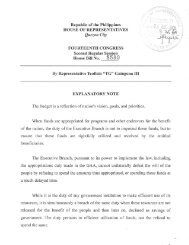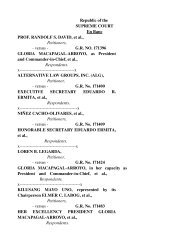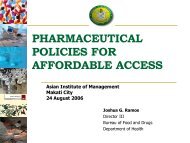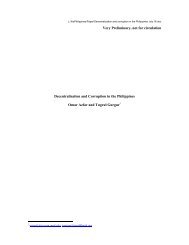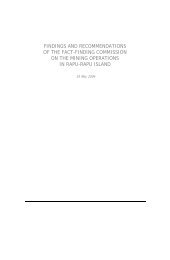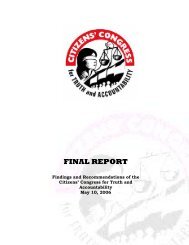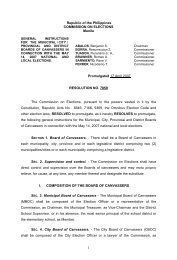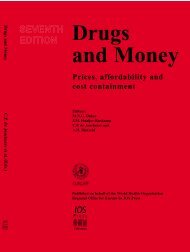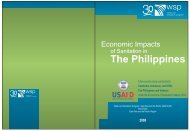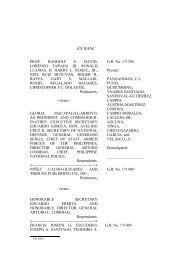The state of water resources in the Philippines - Greenpeace
The state of water resources in the Philippines - Greenpeace
The state of water resources in the Philippines - Greenpeace
Create successful ePaper yourself
Turn your PDF publications into a flip-book with our unique Google optimized e-Paper software.
Classification<br />
Class AA<br />
Waters <strong>in</strong>tended as public <strong>water</strong> supply requir<strong>in</strong>g only approved<br />
dis<strong>in</strong>fection to meet <strong>the</strong> PNSDW<br />
Class A<br />
Waters suitable as <strong>water</strong> supply requir<strong>in</strong>g conventional treatment to<br />
meet <strong>the</strong> PNSDW<br />
Class B<br />
Waters <strong>in</strong>tended for primary contact recreation (e.g. bath<strong>in</strong>g,<br />
swimm<strong>in</strong>g, sk<strong>in</strong> div<strong>in</strong>g, etc.)<br />
Class C<br />
Waters for fishery, recreation/boat<strong>in</strong>g, and supply for manufactur<strong>in</strong>g<br />
processes after treatment<br />
Class D<br />
Waters <strong>in</strong>tended for agriculture, irrigation, livestock <strong>water</strong><strong>in</strong>g, etc.<br />
Table 2. Number <strong>of</strong> classified <strong>in</strong>land surface <strong>water</strong> bodies<br />
(Source: EMB National Water Quality Status Report, 2006)<br />
Number<br />
5<br />
203<br />
149<br />
231<br />
23<br />
This means that only 39 percent <strong>of</strong> <strong>the</strong> 525 <strong>water</strong> bodies may be considered as<br />
potential sources <strong>of</strong> dr<strong>in</strong>k<strong>in</strong>g <strong>water</strong>.<br />
B. Water quality assessment<br />
For <strong>the</strong> period 2001 to 2005, <strong>the</strong> EMB monitored a total <strong>of</strong> 196 <strong>in</strong>land surface<br />
<strong>water</strong>s: 192 rivers and four lakes. Of <strong>the</strong> 196 monitored <strong>water</strong> bodies, only 127<br />
met <strong>the</strong> required four sampl<strong>in</strong>g events and were <strong>in</strong>cluded <strong>in</strong> <strong>the</strong> analysis. Data<br />
on <strong>the</strong> status <strong>of</strong> <strong>water</strong> quality conta<strong>in</strong>ed <strong>in</strong> <strong>the</strong> EMB National Water Quality Status<br />
Report us<strong>in</strong>g each <strong>of</strong> <strong>the</strong> parameters mentioned earlier are presented below.<br />
Dissolved oxygen (DO)<br />
Dissolved oxygen (DO) is <strong>the</strong> amount <strong>of</strong> oxygen that is dissolved <strong>in</strong> <strong>water</strong> and is<br />
essential to healthy streams and lakes. Dissolved Oxygen is one <strong>of</strong> <strong>the</strong> <strong>water</strong><br />
quality parameters used as an <strong>in</strong>dication <strong>of</strong> how polluted <strong>the</strong> <strong>water</strong> is and how<br />
well <strong>the</strong> <strong>water</strong> can support aquatic plant and animal life. A higher dissolved<br />
oxygen level usually <strong>in</strong>dicates better <strong>water</strong> quality. If dissolved oxygen levels are<br />
too low, some fish and o<strong>the</strong>r organisms may not be able to survive (Stevens<br />
Institute <strong>of</strong> Technology, <strong>The</strong> Global Water Sampl<strong>in</strong>g Project 2007).<br />
Generally, <strong>the</strong> national standard for DO is 5 mg/L, except for <strong>water</strong> bodies<br />
classified as Class D and Class SD, with standards set at 3 mg/L and 2 mg/L,<br />
respectively (PEM, 2004).<br />
Low DO levels may be found <strong>in</strong> areas where organic material (dead plant and<br />
animal matter) is decay<strong>in</strong>g, as bacteria require oxygen to decompose organic<br />
waste, thus, deplet<strong>in</strong>g <strong>the</strong> <strong>water</strong> <strong>of</strong> oxygen. Areas near sewage discharges<br />
sometimes have low DO levels due to this effect (Stevens Institute <strong>of</strong><br />
Technology, <strong>The</strong> Global Water Sampl<strong>in</strong>g Project 2007).<br />
Fur<strong>the</strong>rmore, low concentrations <strong>of</strong> DO, when comb<strong>in</strong>ed with <strong>the</strong> presence <strong>of</strong><br />
toxic substances may lead to stress responses <strong>in</strong> aquatic ecosystems because<br />
<strong>the</strong> toxicity <strong>of</strong> certa<strong>in</strong> elements, such as z<strong>in</strong>c, lead and copper, is <strong>in</strong>creased by<br />
low concentrations <strong>of</strong> dissolved oxygen (Enderle<strong>in</strong> et al., 1996).<br />
GREENPEACE | <strong>The</strong> <strong>state</strong> <strong>of</strong> <strong>water</strong> <strong>in</strong> <strong>the</strong> Philipp<strong>in</strong>es 14



